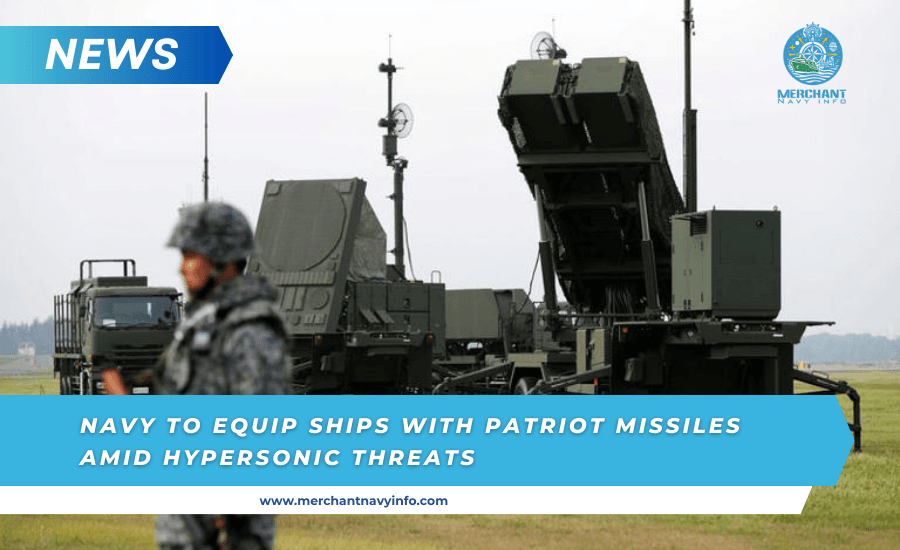
US Navy seeks to equip ships with Patriot missiles amid concerns about Chinese hypersonic weapons.
The U.S. Navy is moving forward with a plan to equip some of its ships with Patriot interceptor missiles amid concerns that China will deploy hypersonic weapons to sink ships in the Pacific, two senior defence officials said.
An industry official said the deployment of the PAC-3 MSE advanced highly resilient Patriot missile, used primarily by the U.S. military, on Navy ships signals advances in Chinese missile technology, including the use of highly maneuverable hypersonic weapons.
The integration of the Lockheed Martin-made missile into the ship’s air defence system comes amid heightened tensions in the Indo-Pacific region following China’s rapid military modernization and successful missile defence efforts in Ukraine and the Middle East.
Tom Karako, a missile defence expert at the Center for Strategic and International Studies in Washington, said the number of PAC-3 interceptors the Navy will need is uncertain. Still, the overall demand is “very high.”
He said foreign governments have shown strong interest and that the U.S. military hopes to more than double production in the coming years.
Industry sources told Reuters that the United States has tapped key ally Japan as a co-production site for Patriot missiles, and Lockheed Martin wants to build a new research missile production line in Florida.
Such a plant would complement Boeing’s research missile manufacturing efforts, and Lockheed Martin is pitching the benefits of additional production to the U.S. Army, which must approve it.
The PAC-3 missile has already shot down a maneuvering hypersonic missile in Ukraine. The U.S. Navy believes it could add another high-probability layer to its anti-missile system, which has not been tested in combat against such weapons.
The Navy told Reuters that the “development roadmap requires further testing, including launching the PAC-3 MSE from a ship and verifying communications with the SPY-1 radar,” the main sensor for the Aegis missile system.
Before this, the U.S. military had unveiled new weapons and strategies in the Indo-Pacific region designed to deter Beijing from conflict or win if it did occur.
Beijing’s most advanced anti-ship ballistic missile, the DF-27, was tested in 2023, and it uses a hypersonic glide vehicle to maneuver to its target. A Pentagon report that year said the weapon was “under development.”
The PAC-3 missile has a shorter range than the Navy’s SM-6 missile and cannot reach space.
But aiming the missile closer to the nose makes it more flexible and more likely to destroy the threat due to the “hit-to-kill” concept, where the interceptor missile hits the target rather than explodes near it, according to the Missile Defense Program, which has direct knowledge of the Aegis system’s director.
In the face of advanced Chinese weapons, including hypersonic glide vehicle warheads, these qualities “can be a good complement to missiles on U.S. ships,” capable of hitting and destroying high-speed, maneuverable ballistic missiles more easily, the program’s director said.
Like industry and defence officials, he declined to be named because he was not authorized to speak to the media.
Growing Threat
The Patriot Missile System’s PAC-3 interceptor missile, used primarily by the U.S. military and allies for ground-based air defence, was tested in May on a “virtual Aegis ship” using an MK 70 vertical launcher, but has not yet been deployed on Navy ships.
But defense officials and people familiar with the matter say it intercepted several ballistic and aircraft threats in the Middle East and Ukraine last year, including advanced Russian Zinzar missiles, making it an attractive addition to the Navy magazine.
The PAC-3 shell is also much smaller than the SM-6 or SM-3, weighing about 300 kilograms (660 pounds) compared to the SM-6’s 1,500 kilograms and about 9 centimetres (3.5 inches) smaller in diameter.
The cost of the missile varies by customer and deal, but estimates put it at about $4 million each.
China has developed a formidable arsenal of anti-ship ballistic missiles, including the DF-21D “tanker killer” and anti-ship warheads for the DF-26 intermediate-range ballistic missile (IRBM).
Tim Wright of the Counter-Missile Program International Institute for Strategic Studies said the DF-27 missile, which the Pentagon says has a range of up to 8,000 kilometres (5,000 miles), appears to use an aerodynamic warhead that can maneuver to evade defences or more easily hit moving targets.









